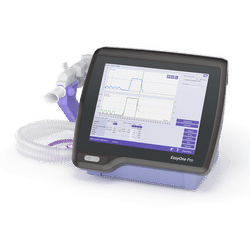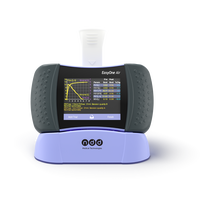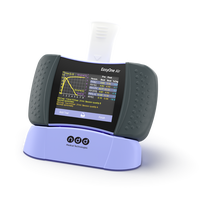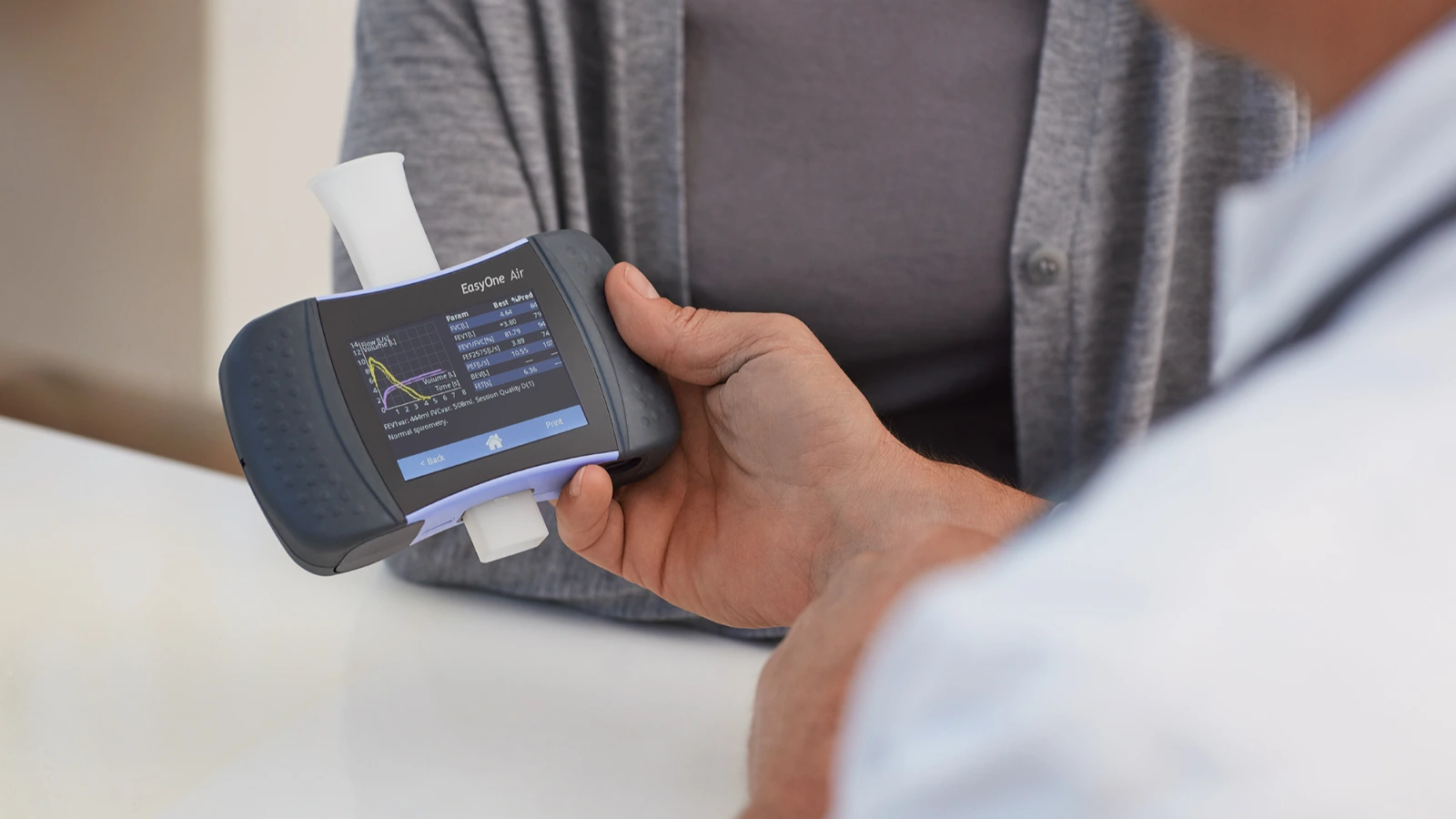Lung function and heart health: Why spirometry and DLCO matter

February is American Heart Month! This year, as part of American Heart Month, we’re highlighting the role that pulmonary function tests (PFTs) — specifically spirometry and diffusing capacity of lungs for carbon monoxide (DLCO) — play in assessing the interplay between the pulmonary and cardiovascular systems.
Cardiovascular diseases, including heart failure (HF), are one of the biggest contributors to morbidity and mortality in the United States and around the world.1
Additionally, due to the necessary role the heart plays in how the lungs function, pulmonary function tests can be crucial for assessing and monitoring cardiopulmonary health.
Understanding pulmonary function tests and their role in assessing cardiopulmonary health #
Dyspnea — the medical term for “shortness of breath” — is one of, if not the number one, most common symptom affecting people around the world.2 But shortness of breath has many different causes, which can present a challenge for physicians. Cardiovascular conditions, such as heart failure, and pulmonary conditions, such as chronic obstructive pulmonary disease (COPD), can both cause shortness of breath, as well as other symptoms. Further, COPD and heart failure are often comorbid, with estimates ranging up to 40% of people with heart failure also living with COPD.3
It’s important to understand that given the complexity of these two bodily systems, teasing out causation is difficult. This underscores why it’s important for clinicians to have an expansive toolbox to assess patients presenting with symptoms that have many different and overlapping causes.
This is where spirometry and DLCO come into play.
Spirometry and DLCO are two different types of pulmonary function tests, each serving different — and complementary — purposes. Spirometry is the most common and measures lung function during forced inhalation and exhalation. Clinicians can evaluate the spirometric indices to determine whether a person is experiencing pulmonary obstruction or restriction (or some combination of both).
DLCO, on the other hand, is intended to measure gas exchange from the lungs into the capillaries through the pulmonary alveoli.
Together, spirometry and DLCO are often used during assessment as diagnostic pulmonary function tests to inform clinicians of what’s causing someone’s shortness of breath.
Let’s discuss how they’re used.
Though COPD and HF have overlapping symptoms and risk factors, spirometry is a useful tool for people with heart failure — and without COPD: One study published in the journal PLOS ONE found that spirometric indices in patients with heart failure with preserved ejection fraction (HFpEF), a type of diastolic heart failure where the heart pumps normally but is unable to properly fill, were independently associated with long-term morbidity and mortality, even in the absence of COPD.3 4People with heart failure often develop pulmonary function abnormalities — usually restrictive in nature due in part to left ventricular hypertrophy and diastolic dysfunction.3
Conversely, spirometry may offer a tool for which to assess those with lung disease at risk of heart failure: In an observational study published in the journal Annals of the American Thoracic Society in 2018, researchers found that both restrictive and obstructive lung disease identify African-Americans at risk for heart failure.5
The connection between DLCO and heart failure #
Early detection of heart failure could save lives and money.6 DLCO may help cardiologists achieve this goal by offering a test that precedes worsening of symptoms and other clinical assessments, enabling earlier intervention.
Interestingly, one study assessing patients with pulmonary hypertension due to HFpEF found that patients regularly had low DLCO despite normal spirometry and chest computed tomography (CT) findings. Further, they found that a low DLCO in this cohort was “strongly and independently associated with the risk of death” — in fact, the risk was almost three times higher.7 Other studies have corroborated this finding.3
As it turns out, there is a plausible mechanism for this: heart failure-induced interstitial edema, alveolar-capillary membrane hydrostatic injury, and altered alveolar fluid clearance cause remodeling that greatly impairs gas exchange between the alveoli and capillaries, leading to persistent reduction of DLCO.8
Why DLCO and Spirometry should be part of routine evaluation for and management of heart failure patients #
DLCO has historically required bulky, complicated machines. Recently, with the advent of portable pulmonary function machines, including our EasyOne Pro and EasyOne Pro LAB, DLCO has become much more accessible, enabling clinics to conduct PFTs outside hospital-based labs.3 This is particularly important as serial testing is necessary to fully actualize the benefits of leveraging PFTs for assessing and monitoring people living with heart failure.
Monitor PFTs in your cardiology office with the EasyOne Pro & Pro LAB—accurate, reliable, and easy to use.
Explore our complete PFT machines today!
Magnussen et. al. examined the existing body of evidence on the value of conducting PFTs in people with HF. Writing in the European Journal of Heart Failure, the authors emphasized that the lungs are not independent of the cardiovascular system and they therefore recommend that DLCO and spirometry, in conjunction with clinical assessment, chest imaging, and natriuretic peptides (a cardiac biomarker), should be part of the initial investigation and follow-up of people with HF.3 They also emphasized that pulmonary function tests offer prognostic value and may influence treatment decisions.
Conclusion #
Simply put: The cardiopulmonary system is complicated, making it difficult to discern what is causing what. As heart failure and chronic obstructive pulmonary disease are leading causes of human suffering and death, comprehensive pulmonary function testing, specifically spirometry and DLCO, enables clinicians to better assess and understand the specific nuances of each patient. Clinicians treating people with heart failure should consider incorporating comprehensive pulmonary function testing as a standard part of care.
Savarese G, Becher PM, Lund LH, Seferovic P, Rosano GMC, Coats AJS. Global burden of heart failure: a comprehensive and updated review of epidemiology. Cardiovasc Res. 2023;118(17):3272-3287. doi:10.1093/cvr/cvac013 ↩︎
Hashmi MF, Modi P, Basit H, Sharma S. Dyspnea. In: StatPearls. StatPearls Publishing; 2025. Accessed January 21, 2025. http://www.ncbi.nlm.nih.gov/books/NBK499965/ ↩︎
Magnussen H, Canepa M, Zambito PE, Brusasco V, Meinertz T, Rosenkranz S. What can we learn from pulmonary function testing in heart failure? Eur J Heart Fail. 2017;19(10):1222-1229. doi:10.1002/ejhf.946 ↩︎ ↩︎ ↩︎ ↩︎ ↩︎ ↩︎
Huang WM, Feng JY, Cheng HM, et al. The role of pulmonary function in patients with heart failure and preserved ejection fraction: Looking beyond chronic obstructive pulmonary disease. PLoS ONE. 2020;15(7):e0235152. doi:10.1371/journal.pone.0235152 ↩︎
Jankowich M, Elston B, Liu Q, et al. Restrictive Spirometry Pattern, Cardiac Structure and Function, and Incident Heart Failure in African Americans. The Jackson Heart Study. Ann Am Thorac Soc. 2018;15(10):1186-1196. doi:10.1513/AnnalsATS.201803-184OC ↩︎
Bayes‐Genis A, Docherty KF, Petrie MC, et al. Practical algorithms for early diagnosis of heart failure and heart stress using NT‐proBNP : A clinical consensus statement from the Heart Failure Association of the ESC. Eur J Heart Fail. 2023;25(11):1891-1898. doi:10.1002/ejhf.3036 ↩︎
Hoeper MM, Meyer K, Rademacher J, Fuge J, Welte T, Olsson KM. Diffusion Capacity and Mortality in Patients With Pulmonary Hypertension Due to Heart Failure With Preserved Ejection Fraction. JACC Heart Fail. 2016;4(6):441-449. doi:10.1016/j.jchf.2015.12.016 ↩︎
Apostolo A, Giusti G, Gargiulo P, Bussotti M, Agostoni P. Lungs in Heart Failure. Pulm Med. 2012;2012:952741. doi:10.1155/2012/952741 ↩︎
Written by

Tré LaRosa
Tré LaRosa is a consultant, scientist, and writer in the Washington, DC area with extensive experience working in research (basic, translational, and clinical) and on patient-reported outcomes. He has also written extensively on neuroscience, pulmonology, and respiratory conditions, including from the patient perspective. He enjoys learning, reading, writing, spending time outdoors, and telling everybody about his mini golden retriever, Duncan.










